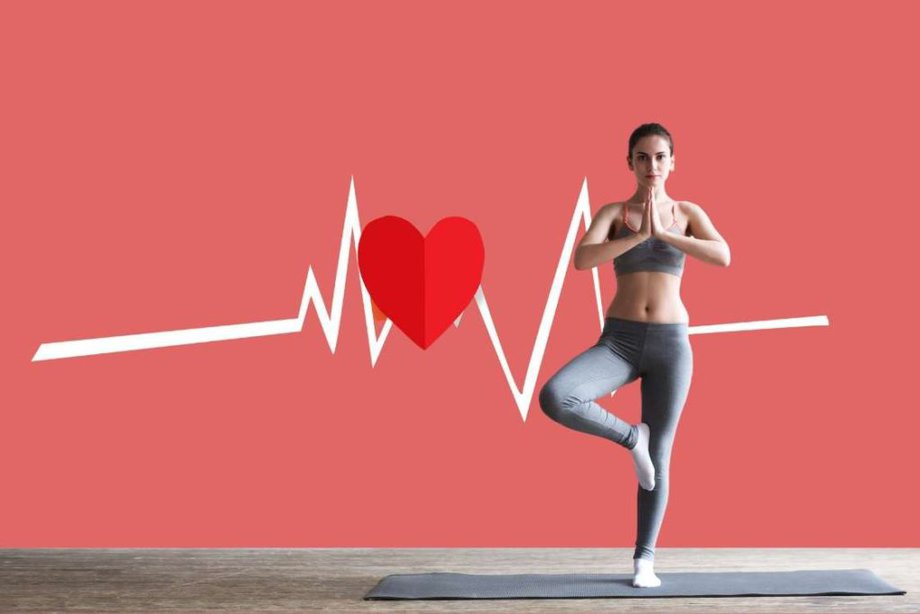Can Hypertension Be Managed With Yoga And Meditation?

Hypertension, commonly known as high blood pressure, is a global health concern affecting a significant portion of the population. It is associated with various complications, including cardiovascular diseases and stroke, making its management crucial. Conventional approaches to hypertension management, such as medication and lifestyle modifications, have been effective to some extent.
However, there is growing interest in exploring alternative and complementary therapies for managing this condition. Yoga and meditation, two practices rooted in ancient traditions, have gained attention for their potential benefits in managing hypertension. This article aims to examine the scientific evidence supporting the use of yoga and meditation as potential interventions for hypertension management.
Additionally, it will explore the potential mechanisms through which these practices may exert their effects and provide recommendations on incorporating them into one’s routine. By adopting an academic and objective approach, this article aims to provide a comprehensive understanding of the effectiveness of yoga and meditation as complementary therapies for hypertension management.
Key Takeaways
- Regular physical activity, such as yoga and meditation, can effectively manage hypertension by reducing stress levels and promoting relaxation.
- Yoga and meditation can improve cardiovascular health and lower blood pressure levels through breathing exercises and mindfulness practices.
- Incorporating yoga and meditation into a daily routine can lead to significant benefits for hypertension management, when tailored to individual needs and monitored regularly.
- Despite challenges such as lack of funding and standardization, further research and collaboration between healthcare professionals, researchers, and policymakers are crucial for the integration of yoga and meditation into mainstream healthcare systems.
Understanding Hypertension
Hypertension, also known as high blood pressure, is a prevalent chronic condition characterized by increased pressure exerted on the arterial walls, and understanding its underlying mechanisms is crucial in exploring potential treatment options such as yoga and meditation.
Hypertension can have various causes, including genetics, obesity, high salt intake, stress, and sedentary lifestyle. By understanding these causes, healthcare professionals can identify the most effective management strategies for each individual.
While conventional treatments such as medication and lifestyle modifications are commonly prescribed, there is growing interest in exploring alternative treatments, such as yoga and meditation, as adjunct therapies. These mind-body practices have shown promising results in reducing blood pressure levels and managing hypertension.
Yoga and meditation may help alleviate stress, improve cardiovascular health, promote relaxation, and enhance overall well-being, making them potentially valuable tools in the management of hypertension. Further research is needed to fully understand the mechanisms underlying these benefits and to determine the most effective ways of incorporating yoga and meditation into hypertension management protocols.
The Benefits of Yoga for Hypertension
One compelling approach to address the challenges of managing blood pressure involves incorporating a mind-body practice that has been shown to have numerous benefits.
Yoga, a popular ancient practice, has gained recognition for its potential positive impact on hypertension. Studies have shown that regular yoga practice can lead to a decrease in systolic and diastolic blood pressure, as well as heart rate.
The physical postures, deep breathing, and relaxation techniques involved in yoga help to reduce stress and promote relaxation, leading to improved cardiovascular health.
Additionally, meditation, a key component of yoga, has been found to have a positive impact on blood pressure. By quieting the mind and focusing on the present moment, meditation can help regulate blood pressure levels.
Overall, incorporating yoga and meditation into a hypertension management plan can provide a holistic approach to improving cardiovascular health.
The Role of Meditation in Managing Hypertension
Meditation has emerged as a promising method for effectively managing blood pressure and promoting overall cardiovascular well-being. The role of meditation in managing hypertension lies in its ability to induce a state of relaxation, reduce stress levels, and enhance mindfulness. Mindfulness techniques, such as focusing on the breath or repeating a mantra, help individuals become aware of their thoughts and emotions in the present moment without judgment. This heightened awareness allows individuals to develop a more balanced response to stressors, reducing the activation of the sympathetic nervous system and decreasing blood pressure. Numerous studies have shown the positive effects of meditation on blood pressure, with some even suggesting that it can be as effective as medication in managing hypertension. Incorporating meditation into hypertension management plans can provide individuals with a non-pharmacological approach that complements traditional treatments.
| Advantages of Meditation for Hypertension |
|---|
| Induces relaxation |
| Reduces stress levels |
| Enhances mindfulness |
Scientific Evidence Supporting Yoga and Meditation for Hypertension
Scientific research has provided substantial evidence to support the incorporation of yoga and meditation as effective complementary approaches in managing high blood pressure. Numerous studies have demonstrated the positive effects of these relaxation techniques on blood pressure control.
Yoga, which combines physical postures, breathing exercises, and meditation, has been shown to significantly reduce both systolic and diastolic blood pressure in hypertensive individuals. Additionally, meditation practices, such as mindfulness and transcendental meditation, have been found to lower blood pressure and promote overall cardiovascular health.
The mechanisms underlying the effectiveness of yoga and meditation for hypertension management are thought to involve stress reduction, improved autonomic nervous system balance, and enhanced mind-body connection. Incorporating these practices into a comprehensive treatment plan can provide individuals with a non-pharmacological approach to managing their hypertension and improving their overall well-being.
Incorporating Yoga and Meditation into Your Routine
Incorporating regular practice of these relaxation techniques can be a valuable addition to daily routines for those seeking to enhance their overall well-being.
Yoga poses and meditation techniques can be easily integrated into one’s routine to help manage hypertension. Here are three ways to incorporate these practices:
- Start with gentle yoga poses: Begin by practicing gentle yoga poses such as child’s pose, cat-cow, and legs-up-the-wall. These poses can help relax the body and reduce stress levels.
- Practice deep breathing: Deep breathing is a fundamental aspect of meditation. Incorporate deep breathing exercises into your routine to promote relaxation and lower blood pressure.
- Set aside dedicated time for meditation: Find a quiet space and set aside a specific time each day for meditation. This can be as little as five minutes initially and gradually increase the duration as you become more comfortable with the practice.
By incorporating yoga poses and meditation techniques into your routine, you can effectively manage hypertension and improve your overall well-being.
Other Lifestyle Changes for Hypertension Management
Maintaining a healthy diet, engaging in regular physical activity, and managing stress through relaxation techniques are key lifestyle changes that can help manage hypertension.
A healthy diet should include reducing sodium intake, increasing consumption of fruits and vegetables, and limiting the intake of saturated and trans fats.
Engaging in regular physical activity, such as aerobic exercises and strength training, can help lower blood pressure and improve overall cardiovascular health.
Additionally, managing stress through relaxation techniques like deep breathing, meditation, and mindfulness can also have a positive impact on hypertension management.
Maintaining a healthy diet
To ensure effective management of hypertension, a healthy diet is crucial. Healthy eating habits play a significant role in maintaining blood pressure levels within a healthy range. Dietary recommendations for individuals with hypertension include reducing sodium intake, increasing potassium intake, and adopting a diet rich in fruits, vegetables, whole grains, lean proteins, and low-fat dairy products. These dietary modifications can help to lower blood pressure and reduce the risk of developing complications associated with hypertension.
The table below provides an overview of foods that are recommended and those that should be limited or avoided for individuals with hypertension:
| Recommended Foods | Limited or Avoided Foods |
|---|---|
| Fruits and vegetables | Processed and packaged foods |
| Whole grains | High-sodium foods |
| Lean proteins | Sugary drinks |
| Low-fat dairy products | Red meat |
By following these dietary recommendations and making appropriate choices, individuals can effectively manage hypertension and improve their overall health.
Engaging in regular physical activity
Engaging in regular physical activity is an essential component of a healthy lifestyle for individuals looking to effectively manage their blood pressure levels and improve overall cardiovascular health. Regular exercise has been shown to have numerous benefits for individuals with hypertension, including lowering blood pressure, reducing the risk of heart disease, improving blood circulation, and promoting weight loss.
To improve cardiovascular health and prevent hypertension complications, individuals should consider incorporating the following activities into their routine:
- Aerobic exercises such as walking, jogging, cycling, or swimming.
- Strength training exercises to build muscle and increase metabolism.
- Flexibility exercises like yoga or stretching to improve joint mobility.
- Balance exercises to reduce the risk of falls and injuries.
By engaging in regular physical activity, individuals with hypertension can reduce their blood pressure levels, improve their cardiovascular health, and minimize the risk of developing complications associated with hypertension.
Managing stress through relaxation techniques
One effective approach for stress management involves incorporating relaxation techniques into one’s daily routine. Managing stress is crucial for individuals with hypertension as it can contribute to elevated blood pressure levels.
Relaxation techniques such as yoga and meditation have been shown to be beneficial in reducing stress and promoting overall well-being. Yoga combines physical postures, breathing exercises, and meditation to promote relaxation and reduce stress. It helps to calm the mind and body, lowering blood pressure and heart rate.
Meditation, on the other hand, focuses on deep breathing and mental concentration to achieve a state of relaxation and mindfulness. It has been found to reduce anxiety and stress levels, which can in turn help manage hypertension.
Incorporating these relaxation techniques into a daily routine can be a valuable tool in managing stress and ultimately controlling hypertension.
Precautions and Considerations
Precautions and considerations must be taken into account when considering the management of hypertension through yoga and meditation. While these practices have shown promise in reducing blood pressure and stress levels, certain precautionary measures need to be implemented to ensure their safety and effectiveness.
Firstly, individuals with severe hypertension or uncontrolled blood pressure should consult a healthcare professional before starting a yoga or meditation program. Additionally, it is important to choose a qualified instructor who can tailor the practice to the individual’s needs and limitations.
Furthermore, individuals with certain medical conditions, such as heart disease or musculoskeletal injuries, should exercise caution and modify poses or techniques accordingly. It is also crucial to start slowly and gradually increase the intensity and duration of the practice to avoid any adverse effects.
Overall, while yoga and meditation can be beneficial for managing hypertension, it is essential to take necessary precautions and consider individual safety considerations before incorporating these practices into a hypertension management plan.
| Precautions | Safety Considerations | Emotional Impact |
|---|---|---|
| Consult healthcare professional | Choose qualified instructor | Sense of empowerment |
| Modify poses as needed | Start slowly and progress gradually | Reduction in anxiety |
| Take into account medical conditions | Listen to your body and avoid overexertion | Improved mood |
| Monitor blood pressure regularly | Practice in a safe and supportive environment | Increased self-awareness |
Conclusion and Future Directions
In conclusion, the benefits of yoga and meditation for hypertension management are significant. Numerous studies have shown that these practices can effectively lower blood pressure and reduce stress levels.
However, further research is needed to fully understand the mechanisms behind these effects and to determine the optimal types and durations of yoga and meditation for hypertension management.
Integrating yoga and meditation into healthcare practices has the potential to enhance the treatment and prevention of hypertension, providing a holistic approach that addresses both the physical and mental aspects of the condition.
Summary of the benefits of yoga and meditation for hypertension management
Yoga and meditation have been found to offer numerous benefits for managing hypertension. Mindfulness, a key component of these practices, has been shown to reduce stress, which is a major risk factor for hypertension.
By focusing attention on the present moment, individuals can cultivate a sense of calm and relaxation, thus lowering blood pressure levels. Additionally, breathing exercises, such as pranayama, have been found to effectively reduce blood pressure and improve cardiovascular health. These exercises involve controlled, deep breathing, which helps to activate the body’s relaxation response and decrease sympathetic nervous system activity.
Furthermore, yoga and meditation have been shown to improve overall physical fitness and promote healthy lifestyle behaviors, such as proper nutrition and regular physical activity, which are essential for hypertension management.
Overall, incorporating yoga and meditation into a comprehensive treatment plan can provide significant benefits for individuals with hypertension.
Potential for further research and integration into healthcare practices
Further research and integration of yoga and meditation into healthcare practices for hypertension management hold great potential. However, progress in this field is hindered by certain barriers.
One major obstacle is the lack of funding opportunities for rigorous scientific studies examining the efficacy of these practices. Due to limited financial resources, it becomes challenging to conduct large-scale clinical trials that can provide robust evidence of the benefits of yoga and meditation for hypertension.
Additionally, there is a need for further standardization and integration of these practices into mainstream healthcare systems. This requires collaboration between healthcare professionals, researchers, and policymakers to develop guidelines and protocols for the safe and effective implementation of yoga and meditation in hypertension management.
Overcoming these barriers will be crucial in expanding the evidence base and ensuring the widespread adoption of these practices in clinical settings.
Frequently Asked Questions
What are the different types of hypertension?
The different types of hypertension include primary and secondary hypertension. Primary hypertension is the most common type and is often caused by lifestyle factors. Secondary hypertension is caused by an underlying medical condition or medication. Lifestyle changes are crucial in managing both types of hypertension.
Can yoga and meditation completely cure hypertension?
Yoga and meditation, as complementary therapies, have been found to have various benefits for overall health. However, there is limited evidence to suggest that they can completely cure hypertension.
Are there any specific yoga poses or meditation techniques that are more effective for managing hypertension?
Effective yoga poses for managing hypertension include Savasana, Viparita Karani, and Sukhasana. These poses promote relaxation, reduce stress, and lower blood pressure. Meditation techniques such as mindfulness meditation and deep breathing can also be beneficial for hypertension management.
How long does it typically take to see results from practicing yoga and meditation for hypertension management?
The duration of practice for yoga and meditation in managing hypertension varies, but studies show that regular and consistent practice over a period of several weeks to months can lead to a significant reduction in blood pressure levels.
Are there any potential side effects or risks associated with practicing yoga and meditation for hypertension management?
Potential risks and safety precautions should be considered when practicing yoga and meditation for hypertension management. It is important to consult with a healthcare professional and ensure proper guidance to prevent any adverse effects.








